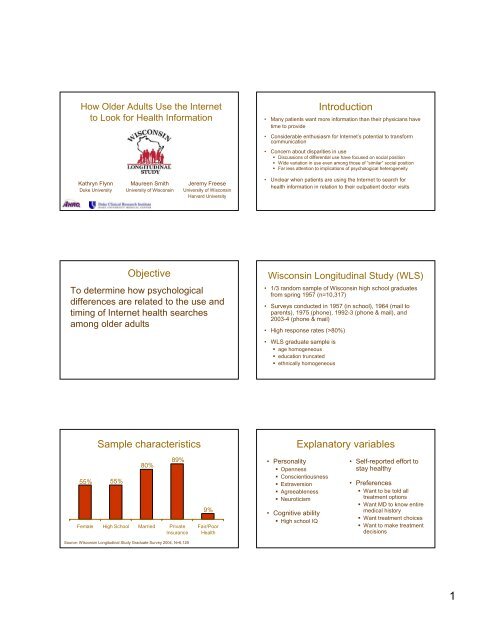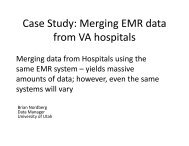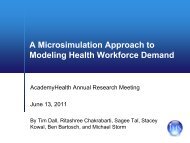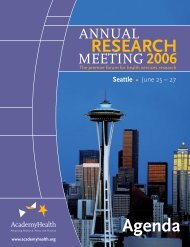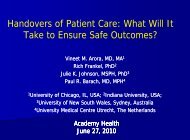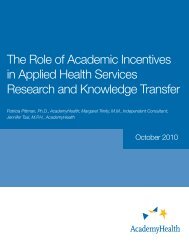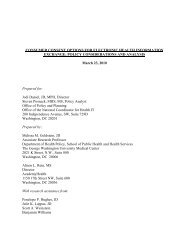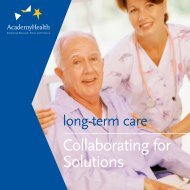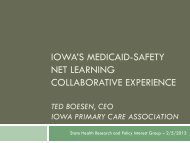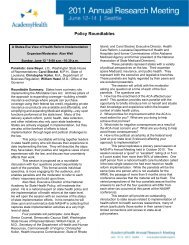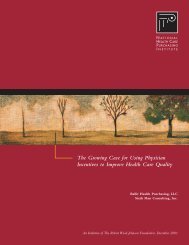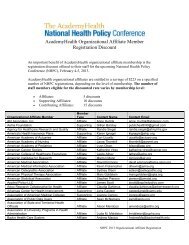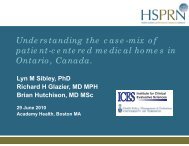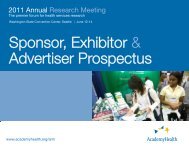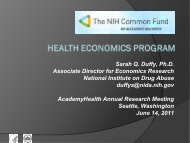PDF Handout of Slides - AcademyHealth
PDF Handout of Slides - AcademyHealth
PDF Handout of Slides - AcademyHealth
You also want an ePaper? Increase the reach of your titles
YUMPU automatically turns print PDFs into web optimized ePapers that Google loves.
How Older Adults Use the Internet<br />
to Look for Health Information<br />
Kathryn Flynn<br />
Duke University<br />
Maureen Smith<br />
University <strong>of</strong> Wisconsin<br />
Objective<br />
Jeremy Freese<br />
University <strong>of</strong> Wisconsin<br />
Harvard University<br />
To determine how psychological<br />
differences are related to the use and<br />
timing <strong>of</strong> Internet health searches<br />
among older adults<br />
55%<br />
Sample characteristics<br />
55%<br />
80%<br />
89%<br />
Female High School Married Private<br />
Insurance<br />
Source: Wisconsin Longitudinal Study Graduate Survey 2004, N=6,125<br />
9%<br />
Fair/Poor<br />
Health<br />
Introduction<br />
• Many patients want more information than their physicians have<br />
time to provide<br />
• Considerable enthusiasm for Internet’s potential to transform<br />
communication<br />
• Concern about disparities in use<br />
Discussions <strong>of</strong> differential use have focused on social position<br />
Wide variation in use even among those <strong>of</strong> “similar” social position<br />
Far less attention to implications <strong>of</strong> psychological heterogeneity<br />
• Unclear when patients are using the Internet to search for<br />
health information in relation to their outpatient doctor visits<br />
Wisconsin Longitudinal Study (WLS)<br />
• 1/3 random sample <strong>of</strong> Wisconsin high school graduates<br />
from spring 1957 (n=10,317)<br />
• Surveys conducted in 1957 (in school), 1964 (mail to<br />
parents), 1975 (phone), 1992-3 (phone & mail), and<br />
2003-4 (phone & mail)<br />
• High response rates (>80%)<br />
• WLS graduate sample is<br />
age homogeneous<br />
education truncated<br />
ethnically homogeneous<br />
Explanatory variables<br />
• Personality<br />
Openness<br />
Conscientiousness<br />
Extraversion<br />
Agreeableness<br />
Neuroticism<br />
• Cognitive ability<br />
High school IQ<br />
• Self-reported effort to<br />
stay healthy<br />
• Preferences<br />
Want to be told all<br />
treatment options<br />
Want MD to know entire<br />
medical history<br />
Want treatment choices<br />
Want to make treatment<br />
decisions<br />
1
• Gender<br />
• Marital status<br />
• # children<br />
• Rural or farm origin<br />
• Educational attainment<br />
• Length <strong>of</strong> relationship<br />
with usual provider <strong>of</strong><br />
care<br />
• SF-12<br />
Physical<br />
Mental<br />
Control variables<br />
• Health insurance<br />
• # prescription meds taken<br />
regularly<br />
• Common conditions<br />
Asthma<br />
Cancer<br />
Diabetes<br />
IBS<br />
Heart disease<br />
Stroke<br />
Hypertension<br />
Joint problems<br />
Analysis<br />
• Multinomial logistic regression<br />
Regress searching behavior on explanatory<br />
variables<br />
Predict adjusted probability <strong>of</strong> each behavior by<br />
explanatory variable with all other variables held<br />
at population mean<br />
State-<strong>of</strong>-the-art computing, 1957 Internet use in WLS sample, 2004<br />
Internet use in WLS sample, 2004<br />
35%<br />
27%<br />
23%<br />
6%<br />
9%<br />
Source: 2004 WLS Graduate Survey, N=6125<br />
2% have used net for health, but don’t have home PC<br />
No home PC<br />
PC, but no net<br />
Net, but not used<br />
Use net, but not for health<br />
Use net for health<br />
35%<br />
27%<br />
23%<br />
6%<br />
9%<br />
Source: 2004 WLS Graduate Survey, N=6125<br />
No home PC<br />
PC, but no net<br />
Net, but not used<br />
Use net, but not for health<br />
Use net for health<br />
Timing <strong>of</strong> last health-related search<br />
6%<br />
1%<br />
16%<br />
12%<br />
65%<br />
Source: 2004 WLS Graduate Survey, N=6125<br />
No health searches<br />
Unrelated to visit<br />
Instead <strong>of</strong> visit<br />
Before visit<br />
After visit<br />
2
Timing <strong>of</strong> last health-related search<br />
Graduate School High School<br />
7%<br />
26%<br />
15%<br />
52%<br />
Source: 2004 WLS Graduate Survey, adjusted for all variables in the full model, *odds ratio significant at p
Timing <strong>of</strong> last health-related search<br />
19%<br />
No Cancer Cancer<br />
10%<br />
4%<br />
67%<br />
Source: 2004 WLS Graduate Survey, adjusted for all variables in the full model, *odds ratio significant at p


